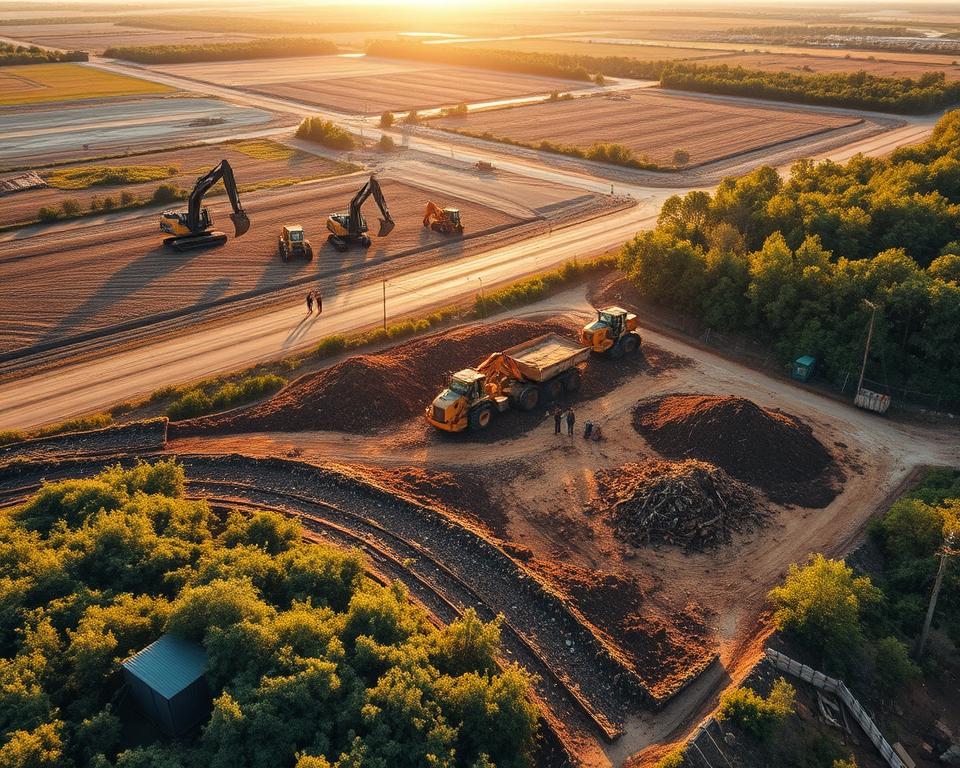Professional Advice: Clear Routes in Wooded Estate
Have you realize approximately eighty percent of homeowners with forest property hardly explore past their yard? That figure highlights the essential need for effective path opening and maintenance. Clearing paths and footpaths in forest areas not only enhances reachability but also improves security and navigation. This article will delve into professional techniques and perspectives from experienced path creators.
These experts will provide ways to design properly-constructed pathways that maximize your outdoor area’s utility while maintaining its ecological wholeness. Uncover the primary factors for land clearing services and techniques for efficient wooded property upkeep solutions. These can make your experience through your natural environment more enjoyable.
Important Takeaways
- Comprehending the value of opening paths for accessibility and safety.
- Analyzing site attributes to define the objective of your trails.
- Employing the right equipment for effective path clearing.
- Selecting suitable surfaces that match with landform.
- Incorporating sustainable practices when opening paths.
- Recognizing common mistakes to avoid during the trail-clearing process.
Why Clearing Trails in Forested Grounds Matters
Preserving open routes in wooded areas is essential for several reasons. It greatly enhances ease of access, making it easier to traverse thick bushes. This permits property owners and visitors to completely appreciate the landscape. This clearing also facilitates different pursuits like walking, birdwatching, or just relishing nature.
Enhancing Accessibility
Open paths not only facilitate travel; they also deepen our connection with the natural world. By improving approachability, owners open up the open air to a wider audience. Such benefits is useful for individual enjoyment or community events, encouraging exploration and valorization of the environment.
Enhancing Safety and Direction
The importance of safety on woodland trails is paramount. Defined routes provide clear navigation and minimize hazards from uneven terrain, concealed barriers, or sudden plant growth shifts. Property owners commit in establishing safe routes, increasing confidence in outdoor adventures.

Planning Your Woodland Trail
Effective trail design demands a deep knowledge of the terrain. It is about evaluating terrain and site conditions. Understanding the trail’s purpose is also key, as it informs construction and maintenance.
Evaluating Terrain and Site Conditions
When evaluating ground, several factors are essential. These include:
- Soil types that influence water flow and steadiness
- Slope degree impacting ease of access and safety
- Current plant life that may require removal or protection
By assessing these factors, trails can endure various weather conditions. Such routes also support regular pedestrian use. This approach guarantees the trail is long-lasting and honors the ground’s natural features.
Defining Your Trail’s Purpose
Path planning success depends on a well-defined purpose. Think about the uses the trail will support, such as:
- Leisurely strolling and nature appreciation
- Entry for upkeep or ground management
- Opportunities for wildlife observation and education
Understanding the trail’s goal directs multiple choices. Such understanding includes the path’s width and construction materials. Recognizing the path’s goal is vital for crafting a route that fulfills its requirements.
Tools Needed for Trail Clearing
Productive trail opening requires the proper gear for different tasks. The appropriate equipment boost efficiency and safety, streamlining the process. The selection between hand tools and motorized equipment depends on the project’s scale, terrain, and material volume.
Key Manual Instruments
Hand tools are essential for precision and versatility in opening dense areas. Essential tools include:
- Loppers: Ideal for cutting through thick branches and bushes.
- Hand saws: Perfect for detailed slicing on wood limbs.
- Digging tools: Useful for excavating and creating water channels.
These tools offer a hands-on approach, essential for delicate spots where machinery could damage.
Power Tools for Productivity
For large-scale trail clearing jobs, motorized devices are a game-changer. Such equipment make the process speedier and more productive. Crucial equipment include:
- Chain saws: Excellent for felling large trees and slicing thick underbrush.
- Brushcutters: Quick for removing thick turf and smaller saplings.
Power equipment reduces opening time, making it ideal for extensive zones. Safe operation is imperative to prevent accidents.
Approaches for Path and Trail Preparation
Clearing paths and tracks in wooded areas demands thoughtful planning. It is essential to balance practicality with eco-friendliness. Effective vegetation management maintains the environment’s balance while establishing useful pathways. This balance is crucial to a positive outdoor experience.
Clearing Overgrowth and Vegetation
Selective clearing techniques are essential when dealing with overgrowth. Hand tools enable for accurate extraction of unwanted plants without damaging the ecosystem. Such approach promotes the growth of desired plants while controlling invasive ones. Regular upkeep stops resurgence, improving trail safety and accessibility.
Designing Eco-Friendly Trails
A eco-conscious route layout is more than just looks; it involves selecting resources that reduce erosion and improve drainage. These methods honor the natural landscape and lessen ecological impact. Employing native stones or recycled timber bolsters durable durability and environmental balance. Thoughtful planning strikes a equilibrium between usability and eco-protection.
Trail Surface Options: Finding the Right Fit
Selecting the right path covering is vital for both functionality and durability. The choice between natural and man-made coverings affects maintenance, comfort, and trail longevity. Knowing the different materials and their suitability for your ground is crucial to establishing an ideal route.
Natural vs. Man-Made Surfaces
Natural surfaces, such as pebbles, broken rock, or mulch, are often more affordable. They integrate well with the environment, facilitating drainage and a organic appearance. In contrast, man-made surfaces like concrete pavers are more durable and appropriate for heavy use. Each type has its benefits and drawbacks, based on the planned use and climate factors.
Choosing the Right Materials for Your Terrain
Selecting the right materials includes considering soil type, drainage needs, and budget. Below is a basic guide to popular materials:
| Material | Advantages | Disadvantages | Cost per Square Foot |
|---|---|---|---|
| Gravel | Affordable, Effective water flow | May need frequent replenishing | $1 – $3 |
| Crushed Stone | Steady footing, Natural look | Can be difficult to walk on in wet conditions | $2 – $5 |
| Wood Chips | Eco-friendly, Soft underfoot | Needs frequent topping up | $1 – $2 |
| Concrete Pavers | Durable, Low maintenance | More expensive initially | $5 – $15 |
Carefully choosing ground coverings guarantees your routes are functional and compliment the site’s natural beauty.
Building Bridges and Turnpikes
Creating paths in forest areas requires careful planning of level shifts. This is key for even crossings across various terrains and ensuring trail accessibility over time. Constructing bridges for trails is often required, mainly when spanning wet areas or low-lying ground.
Identifying When to Add Height Variations
Height in trail layout is often due to irregular ground. Major level changes necessitate builds like overpasses or raised walkways to maintain path soundness. This method helps prevent soil erosion and ensures security, essential for both casual hikers and serious nature lovers.
Choosing Bridge Materials for Marshy Terrain
The selection of supplies for elevated walkways and overpasses is key for their security and longevity. Timber beams, concrete blocks, or treated lumber can provide the necessary strength against weight and environmental factors. It’s important to choose supplies that are moisture-proof to prevent degradation and allow future modifications.
Trail Maintenance and Upkeep
Maintaining trails safe and accessible requires ongoing care. Regular checks help identifying problems early, ensuring visitors have a positive time. It’s essential to upkeep trails seasonally, as climatic shifts can impact them. This section will discuss a comprehensive maintenance checklist and the benefits of hiring expert path care solutions.
Year-Round Upkeep Tasks
A thorough checklist helps path custodians maintain their trails in top shape year-round. Key tasks include:
- Clearing obstacles such as downed limbs and foliage.
- Inspecting trail surfaces for wear and tear, following bad weather.
- Checking water channels to avoid flooding.
- Repairing soil washout by supplementing gravel as needed.
- Updating markers and signs for clear direction.
Expert Path Care Providers
For those needing professional assistance, specialized path care solutions are a great choice. They offer:
- Comprehensive path evaluations by skilled experts.
- Advanced repairs and renewal of busy paths.
- Employing specialized equipment for better surface care.
- Implementing eco-friendly practices to prolong path longevity.
Hiring expert path care saves your time for other activities. It also brings in expert skill.
Landscaping Surrounding Paths
Landscaping is key to rendering paths attractive. By carefully selecting flora and materials, you can craft an welcoming environment. This not only draws visitors but also aids local habitats. The ideal vegetation for trails provide aesthetic appeal and maintain ecological balance.
Incorporating Flora for Aesthetic Appeal
When planning pathside planting, selecting the appropriate plants is essential. Native plants are perfect as they naturally fit in with the surroundings. They need less maintenance and provide habitat for local wildlife. Mix flowering plants, shrubs, and grasses for a diverse, attractive ambiance around paths.
Using Stones and Edging Materials
Edging materials like rocks and bricks are important for trail structure. They outline the path and contribute to its design. These elements stop ground washout and provide a neat border with plants. Using different textures and hues can render the path more interesting.
Environmental Considerations in Trail Clearing
Trail clearing projects should prioritize environmental sustainability. Responsible ground care methods help protect the area’s ecological integrity. This approach makes sure trails harmonize with nature harmoniously.
Eco-Friendly Clearing Methods
Embracing eco-conscious approaches in path clearing is critical. Minimal-impact methods reduce land degradation and safeguard habitats. Targeted removal and eco-friendly materials reduce land disturbance.
Learning the terrain and plant life is key. It aids responsible clearing and improves trail functionality.
Impact on Local Wildlife and Flora
Fauna evaluations are important in path construction. They help measure the project’s impact on local animals and flora. This permits for necessary changes before construction starts.
Spotting sensitive species’ habitats avoids environment disruption. This balance ensures a vibrant environment for all.
Path constructors can create sustainable routes with careful planning. This commitment to eco-friendly practices and wildlife well-being enhances nature engagement. It reconciles recreational activities with eco-protection.
Pitfalls to Avoid in Path Opening
Participating in trail clearing requires avoiding common pitfalls to prevent ongoing issues. Identifying these errors allows for better preparation and implementation. By focusing on straightforward trail layout and addressing drainage, one can avoid extensive upkeep demands.
Over-Complicating the Path Design
Trail design often falls into the pitfall of overengineering trail layout. Numerous enthusiasts think complex layouts render paths more appealing. Yet, straightforwardness is often the secret to effectiveness. Simple routes enhance navigation and upkeep, reducing hurdles.
Avoidable twists and elaborate elements can lead to trail mistakes. These errors hinder usage and wayfinding, making trails less pleasant.
Ignoring Drainage Needs
Ignoring water control issues in paths can have severe outcomes. Adequate drainage planning avoids water accumulation, which can wash out trails and harm grounds. Adequate drainage solutions are essential for a long-lasting trail.
Ensuring proper runoff from the path safeguards the route and protects the ecosystem. This enables for a more pleasant nature excursion.
To Summarize
Trail clearing is essential for those who desire to completely appreciate their wooded properties. It improves ease of access and safety, making outdoor spaces enjoyable for everyone. Woodland paths offer more than just scenic appeal; they provide chances for leisure and learning about the environment.
Successful design and implementation are crucial in path opening. Evaluating ground and selecting the right materials are essential for establishing lasting routes. Regular maintenance keeps these paths safe and accessible, fostering a continuous connection with the outdoors.
By grasping the concepts discussed here, you can design and maintain trails that serve both functional and recreational needs. Embracing forest paths can turn your property into a sanctuary for exploration, rest, and valuing nature.
